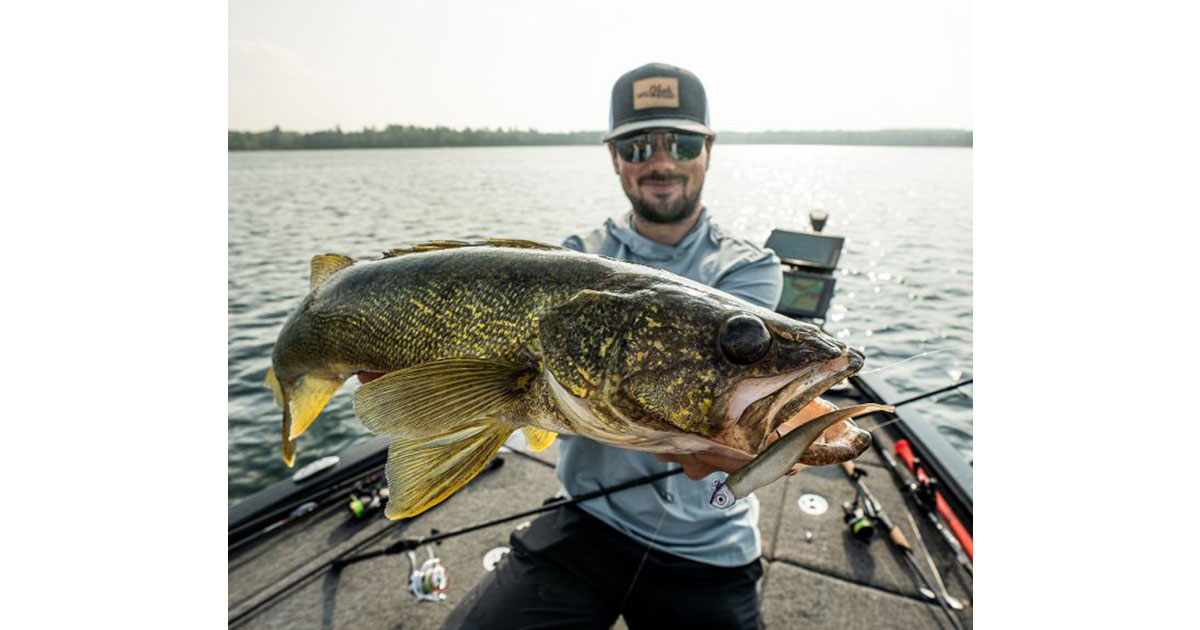- Details
Z-Man Report
 Z-Man walleye pro Dylan Nussbaum
Z-Man walleye pro Dylan Nussbaum
Do we really need another story about catching fish with forward-facing sonar (FFS), the singular topic that seems to invade every fishing conversation today?
If you ask any young angler today—or many old-timers, to boot—the answer would seem to be a resounding yes. “Almost every question I get these days is related to FFS,” notes Z-Man walleye pro Dylan Nussbaum, a sonar sight fishing prodigy. “Anglers want to know how to set it up, how to trigger ‘sonar fish’ to bite and especially, which lures to use with FFS and how to retrieve them.”
According to super skilled, youthful anglers like Nussbaum, fishing traditions are shifting. Young, energetic fishermen are mastering new skillsets, birddogging bogeys on fish radar and firing heatseeking missiles with military-like precision. Moreover, as Nussbaum and other FFS specialists will suggest, going one-on-one with big fish, flipping a jig and Jerk ShadZ™ on their piscine snouts is an absolute adrenaline rush.
“We watch videos and read so much about fishing with sonar these days, but I think there’s a lack of content really explaining how and why we do what we do when we’re up front, crouched over a screen, flicking baits and setting hooks. Sure, I use FFS to catch big fish and win tournament money, but the truth is, it’s also an awesome learning experience and honestly, one of the most exciting and rewarding ways to catch ‘em.”
Z-Man: Seems like the power of FFS has really been on display at recent walleye tournaments. Most eye raising are the big water tournaments, like on Lake Erie, where trolling methods that cover large swaths of water are gradually being supplanted by casting a single lure to a single fish spotted on sonar. Why are anglers adapting?
Dylan Nussbaum: Beyond the fun factor, of course, it all boils down to the fact FFS helps us pinpoint and cast to individual big fish, one-on-one with a favorite lure, as opposed to towing lures around the general vicinity of a school, hoping one will eventually eat. In tournaments, we’re looking to put five big fish in the boat each day, rather than seeking limits of smaller eater sized fish.
- Details
By Louie Stout
I know you guys are catching walleye. So why aren’t you entering them in the Midwest Walleye Challenge?
As of Thursday, only 24 Hoosiers had entered and logged 146 fish from 32 Indiana bodies of water. Oddly enough, southern Indiana – mostly Brookville Reservoir - has dominated the Hoosier entries.
However, some entries have come from Clear and Crooked lakes in Steuben County. Strangely, none have been entered from the St. Joseph River, Maxinkuckee or Winona lakes where walleyes are frequently stocked.
- Details
IDNR Report
Indiana anglers are invited to participate in the 2024 Midwest Walleye Challenge, a virtual fishing tournament that offers the opportunity to win prizes and contribute to fisheries management while providing Indiana Department of Natural Resources (DNR) fisheries biologists with valuable data on the state’s walleye, sauger, and saugeye populations.
The tournament begins March 30 and ends June 30. Only catches of walleye, sauger, and saugeye will count in the tournament.
The Midwest Walleye Challenge was piloted in Iowa during the past two years. This year it will be offered across the Midwest as part of a larger fisheries research project funded by the Association of Fish and Wildlife Agencies.
- Details
By Louie Stout
Fall walleye stockings in Pine and Stone lakes the past three years appear to be delivering positive results.
Indiana has stocked the two lakes “off and on” since 1990. However, the DNR and private groups have been consistently stocking larger fall fish in the connected lakes since 2021 with improved results.
Stocking numbers have been 4,926 in 2021, 6,172 in 2022 and 3,610 in 2023. While those numbers seem low, studies have shown that you get better results with low numbers of larger fish than you do with high numbers of tiny fish.
The fall fish sizes range from 4.8 to 6.2 inches when they go into the lake.
District fisheries biologist Tom Bacula conducted a survey there last fall and was pleased with the preliminary results.
“We found several year-one (2022) walleyes last fall and they looked good,” he said. “There’s a good chance anglers will begin seeing legal-size fish from the 2021 stocking this season.”





